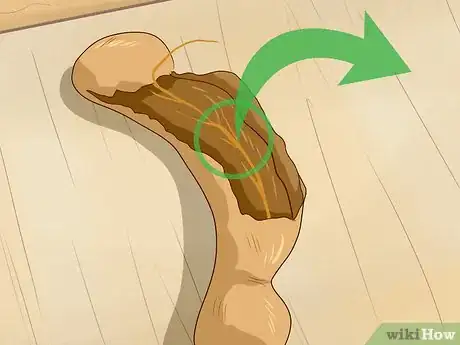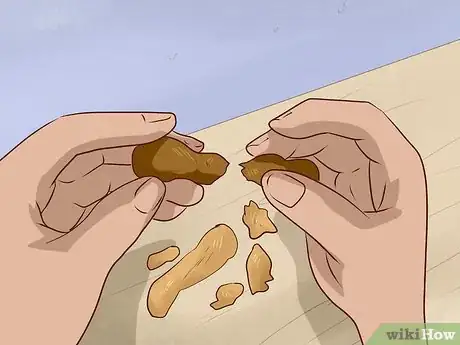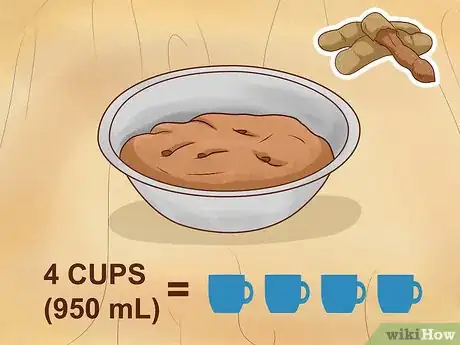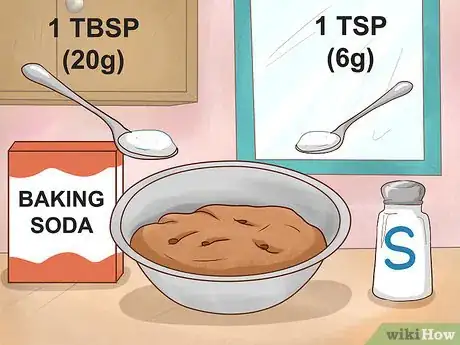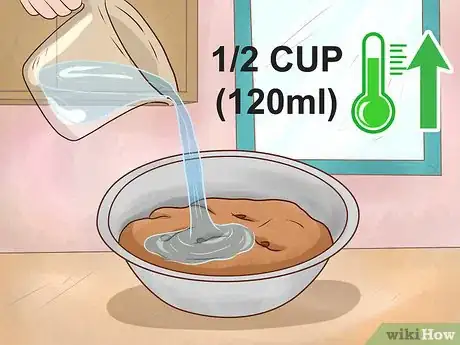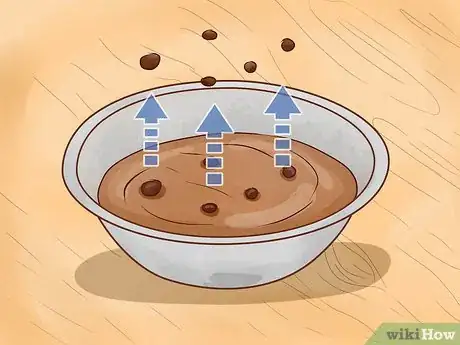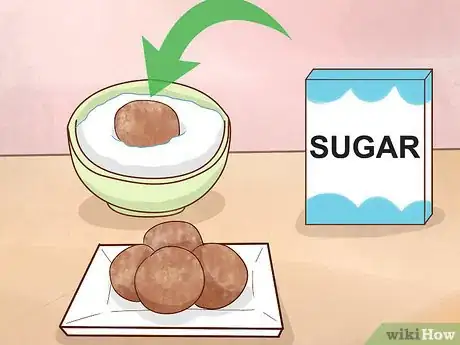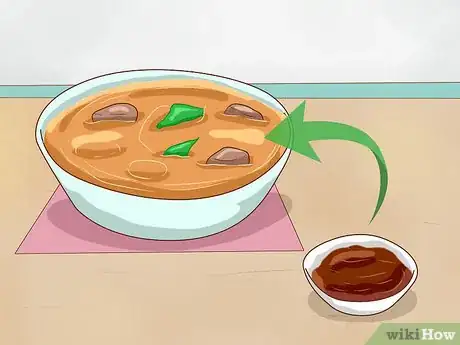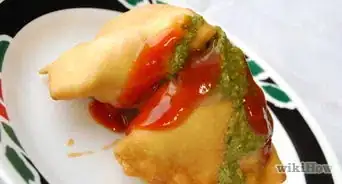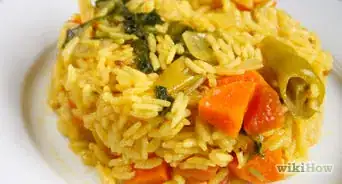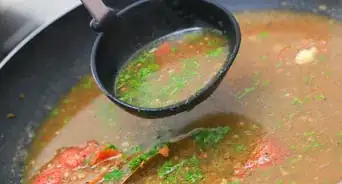This article was co-authored by wikiHow staff writer, Amy Bobinger. Amy Bobinger has been a writer and editor at wikiHow since 2017. She especially enjoys writing articles that help people overcome interpersonal hurdles but frequently covers a variety of subjects, including health and wellness, spirituality, gardening, and more. Amy graduated with a B.A. in English Lit from Mississippi College in 2011 and now lives in her hometown with her husband and two young sons.
There are 9 references cited in this article, which can be found at the bottom of the page.
This article has been viewed 75,790 times.
Learn more...
Tamarind, also known as the Indian date, is a tart fruit which is popular in cuisines from Southeast Asia and India. The edible pulp is contained in a long, narrow pod filled with seeds, similar to a bean. You can eat the pulp raw, or you can use it to add a sweet and sour component to a number of dishes and drinks. You can also use tamarind concentrate, paste, syrup, or juice to infuse the tangy sweetness to your favorite dishes![1]
Ingredients
- 4 cups (950 mL) tamarind pulp
- 1⁄2 cup (120 mL) boiling water
- 1 tbsp (20 g) baking soda
- 1 tsp (6 g) salt
- 4 cups (800 g) granulated sugar
- 1/2 tsp hot chile powder (2.6 g) (optional)
Steps
Eating Raw Tamarind
-
1Crack open the tamarind pod. Tamarind is often sold in whole pods, which can either be fresh or dried. Holding the tamarind pod in both hands, bend it until it snaps, splitting to reveal the pulp and seeds inside.[2]
- If the pods are tough, you can soak them in hot water to soften them before you peel them.[3]
- You can find tamarind pods at some Asian supermarkets, or you can buy them dried online.
- Store tamarind pods in a cool, dark place, like the back of a cabinet, where they’ll keep indefinitely.
-
2Pull away the strings that hold the flesh in place. When you break open the pod, you’ll see strings attaching the pulp to the pod. Grasp these with your thumb and forefinger and pull them away from the fruit. They should pull away easily.[4]
- This process is similar to removing the strings from string beans.
Advertisement -
3Break off a piece of the pulp with your fingers and eat around the seeds. The flesh of the tamarind is tart. It’s more sour when the fruit is slightly unripe and becomes sweeter as the pod ages. Nibble the flesh from around the seeds, much like when you’re eating a cherry or a grape with seeds that you don’t want to chew.[5]
- Keep damp paper towels nearby, since eating tamarind this way can be sticky.
Making Tamarind Balls
-
1Separate 4 cups (950 mL) of tamarind pulp into clumps in a bowl. Use your fingers to break the pulp into large pieces. You can either use tamarind concentrate or the pulp from raw tamarind pods. There is no need to de-seed the tamarind pods first, nor to remove any seeds that might be contained in the tamarind concentrate.[6]
- The pulp fibers are attached tightly to the seeds, so it's easier to remove the seeds after you mix hot water into the pulp later in the process.
- Although most seeds are removed from tamarind concentrate, it’s common to find a few, especially in rustic preparations.
-
2Mix 1 tbsp (20 g) of baking soda and 1 tsp (6 g) of salt in with the pulp. Stir them together as well as you can. However, since the pulp will still be in clumps, the ingredients won’t be fully combined.[7]
- Stir until you don't see any more clumps of the dry ingredients.
-
3Pour 1⁄2 cup (120 mL) of boiling water onto the tamarind and stir. Heat the water to boiling on the stove or in the microwave, then pour it over the tamarind pulp. The boiling water will help dissolve the tamarind pulp, allowing the baking soda, salt, and tamarind to combine.[8]
- As you stir, the water will be absorbed. Once it's fully absorbed, the tamarind mixture should resemble a thick paste.
-
4Separate the seeds once the pulp and water are mixed. As the pulp dissolves in the hot water, the seeds will separate, making it easier for you to remove them from the mixture. Take your time removing the seeds to make sure no one bites down on one while enjoying your tamarind candy.
- Either wait until the tamarind has cooled, or use a fork or other utensil so you don’t burn yourself.
-
5Mix in 2 cups (400 g) of granulated sugar. The recipe calls for 4 cups (800 g) of sugar in total, but at this point, you only need to use about half of that. Add the sugar, then stir the mixture until the sugar is completely blended into the rest of the ingredients.[9]
- If you want a sweet and spicy treat, add in 1/2 tsp (2.6 g) of hot chili powder, such as habanero. However, this is optional.
- Once you stir in the sugar, the tamarind mixture should be somewhat grainy but still sticky.
-
6Cover the bowl and leave it at room temperature for 12 hours. Tamarind balls take a little patience, but the end result will be worth it. Cover the bowl with plastic wrap or a towel and let the mixture rest for about 12 hours.[10]
- There’s no need to refrigerate the mixture. Just place it somewhere on your counter where it won’t be disturbed.
-
7Stir in the remaining 2 cups (400 g) of sugar before you form the balls. Since the texture of tamarind can vary depending on its ripeness, the texture of the tamarind mixture may also vary. If the mixture isn’t firm enough to hold its shape, add more sugar to the bowl and stir it in.[11]
- If you need to add more sugar, add it in 1/8 cup (25 g) increments until you reach the desired texture.
-
8Shape the mixture into balls with your hands. Take a small amount of the tamarind mixture in your hands and use your palms to roll it into a small ball. You can make the balls any size you like, but tamarind balls are usually about the size of a golf ball.[12]
- Wash your hands frequently while rolling out the tamarind balls, since the candy mixture is sticky!
-
9Let the tamarind balls sit for another 2-3 hours to dry out. Once the balls have been formed, they need to rest again for several hours before you serve them. This will allow this sweet and sour treat to develop the perfect texture.[13]
-
10Roll the balls in sugar and enjoy. Pour a little granulated sugar onto a plate and roll each ball across the sugar so you have a light dusting on the outside of each treat. Then, set out the tamarind balls and let everyone enjoy a few![14]
- If you have any leftover tamarind balls, place them in an airtight container in the refrigerator, where they’ll last for several days.
Cooking with Tamarind
-
1Add tamarind paste to your favorite curry dish or soup. Tamarind adds a delicious sweet-and-sour flavor to curry, soups, stews, dhal, or chili. A little of the paste goes a long way, so just add a dab during the cooking process.[15]
- Tamarind is a common ingredient in Southeast Asia, where it is often used in curries.
-
2Glaze savory meat dishes with tamarind concentrate. Tamarind adds a tart sweetness to savory dishes, and since it helps tenderize meat, it’s perfect for using as a glaze. Try it on fish, chicken, pork, or ham for a unique flavor with a global appeal.[16]
-
3Pour tamarind juice or syrup into a whiskey or bourbon cocktail. Tamarind can help you create your very own world-class cocktail! The sour taste of tamarind helps to balance the smoky flavor of whiskey and bourbon.[20]
- You can also try tamarind in a gin cocktail.
- Tamarind juice may not have any added sugar, but the syrup is usually sweetened, so take that into account when you’re planning the other ingredients in your cocktail.
-
4Toss a little tamarind paste into stir fry or pad thai. If you’ve ever wondered why your homemade pad thai doesn’t taste quite like your favorite restaurant’s, the answer might be tamarind. This tangy fruit is a popular addition in many Pan-Asian dishes.[21]
-
5Add tamarind to sweet dishes to boost their flavor. You’ll get an extra dimension of flavor by adding in a little tamarind concentrate to cakes, caramels, pies, and other desserts. Just mix it in before you cook to allow the flavors to really meld together.[22]
References
- ↑ http://theepicentre.com/ingredient/cooking-with-tamarind/
- ↑ https://www.tastingtable.com/cook/national/tamarind-recipes-how-to-eat-use
- ↑ http://theepicentre.com/ingredient/cooking-with-tamarind/
- ↑ http://theepicentre.com/ingredient/cooking-with-tamarind/
- ↑ http://theepicentre.com/ingredient/cooking-with-tamarind/
- ↑ http://theepicentre.com/?recipe=tamarind-balls
- ↑ http://theepicentre.com/?recipe=tamarind-balls
- ↑ http://theepicentre.com/?recipe=tamarind-balls
- ↑ http://theepicentre.com/?recipe=tamarind-balls
- ↑ http://theepicentre.com/?recipe=tamarind-balls
- ↑ http://theepicentre.com/?recipe=tamarind-balls
- ↑ http://theepicentre.com/?recipe=tamarind-balls
- ↑ http://theepicentre.com/?recipe=tamarind-balls
- ↑ http://theepicentre.com/?recipe=tamarind-balls
- ↑ https://www.bbc.com/food/tamarind
- ↑ https://www.thekitchn.com/ingredient-spotlight-tamarind-90224
- ↑ https://www.allrecipes.com/recipe/231798/grilled-tamarind-and-orange-glazed-chicken/
- ↑ https://www.bonappetit.com/recipe/spicy-tamarind-and-honey-glazed-spiral-ham
- ↑ http://theepicentre.com/ingredient/cooking-with-tamarind/
- ↑ https://food52.com/blog/16122-ottolenghi-s-secret-ingredient-how-to-use-it-in-cocktails-cakes-curries-etc
- ↑ https://www.bonappetit.com/ingredient/tamarind
- ↑ https://food52.com/blog/16122-ottolenghi-s-secret-ingredient-how-to-use-it-in-cocktails-cakes-curries-etc
About This Article
To eat tamarind from the pod, use your fingers to bend the pod until it snaps open. Pull away the strings that attach the pulp to the pod, then break off a small piece of the pulp. Nibble at the pulp, being careful not to bite down or swallow the seeds that are contained inside. For tips on cooking with tamarind, keep reading!

